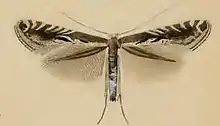| Parornix anglicella | |
|---|---|
 | |
 | |
| Scientific classification | |
| Domain: | Eukaryota |
| Kingdom: | Animalia |
| Phylum: | Arthropoda |
| Class: | Insecta |
| Order: | Lepidoptera |
| Family: | Gracillariidae |
| Genus: | Parornix |
| Species: | P. anglicella |
| Binomial name | |
| Parornix anglicella (Stainton, 1850) | |
| Synonyms | |
| |
Parornix anglicella is a moth of the family Gracillariidae. It is widespread in: Europe including Albania, Austria, Belarus, Belgium, Bosnia and Herzegovina, Britain, Bulgaria, Croatia, Corsica, Czech Republic, Danish mainland, Estonia, Finland, French mainland, Germany, Hungary, Ireland, Italian mainland, Latvia, Lithuania, Luxembourg, Montenegro, North Macedonia, Norwegian mainland, Poland, Portuguese mainland, Romania, central and northern Russia, Sardinia, Serbia, Sicily, Slovakia, Slovenia, Sweden, Switzerland, Netherlands, Ukraine. Outside Europe it is recorded from the Near East and Nearctic realm.
The wingspan is 9–11 mm. The head is ochreous-whitish mixed with fuscous. Palpi white, apex of second joint and median band of terminal dark fuscous. Forewings are dark fuscous, irrorated with whitish ; numerous costal strigulae, a spot in middle of disc and another posteriorly, and suffused dorsal strigidae interrupted by two blackish spots white ; a black apical dot ; cilia with three entire dark fuscous lines. Hindwings are grey. The larva is pale greenish-grey ; dorsal line darker ; spots pale ; head pale greenish-brown ; segment 2 with four black spots.[1]
Adults are on wing in two generations in April and May and again in August.
The caterpillars usually feed on Crataegus species, but have also been recorded on Mespilus germanica, Sorbus aucuparia and Fragaria species.
References
- ↑ Meyrick, E., 1895 A Handbook of British Lepidoptera MacMillan, London pdf
 This article incorporates text from this source, which is in the public domain. Keys and description
This article incorporates text from this source, which is in the public domain. Keys and description
External links
 Media related to Parornix anglicella at Wikimedia Commons
Media related to Parornix anglicella at Wikimedia Commons Data related to Parornix anglicella at Wikispecies
Data related to Parornix anglicella at Wikispecies- UKmoths
- Image of Larva Archived 2011-07-23 at the Wayback Machine

